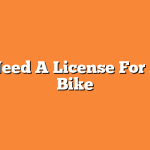If you’re interested in riding a dirt bike, you may be wondering if you need a motorcycle license.
The answer is not straightforward and depends on several factors, including your age, the engine size of the dirt bike, and local laws and regulations.
In this article, we’ll explore these factors and provide you with a comprehensive guide to help you determine whether you need a motorcycle license for a dirt bike.
First and foremost, it’s essential to understand the engine size of the dirt bike you plan to ride.
Different engine sizes require different licenses and endorsements.
For example, if the engine size of the dirt bike is less than 50cc, you may not need a motorcycle license to ride it.
However, if the engine size is over 50cc, you’ll likely need a motorcycle license or a special endorsement on your driver’s license.
Additionally, age restrictions may apply, and you’ll need to follow state and local laws regarding dirt bike riding.
In the following sections, we’ll dive deeper into these topics, providing you with all the information you need to know about dirt bike riding and licensing.
Table of Contents
- 1 Understanding Dirt Bike Engine Sizes
- 2 Age Restrictions for Dirt Bike Riders
- 3 State and Local Laws for Dirt Bike Riding
- 4 Safety Gear Requirements for Dirt Bike Riding
- 5 Off-Road Riding Techniques and Best Practices
- 6 Dirt Bike Training and Certification Programs
- 7 Insurance Considerations for Dirt Bike Owners
- 8 Frequently Asked Questions
- 9 Conclusion
Understanding Dirt Bike Engine Sizes
You’ll wanna know that when it comes to dirt bike engine sizes, the bigger the engine, the more power and speed you’ll have.
However, it’s important to note that dirt bike horsepower limitations vary by state.
In some states, you may be required to have a motorcycle license to operate a dirt bike with an engine larger than a certain size.
Choosing the right dirt bike for your skill level is crucial to ensuring a safe and enjoyable ride.
If you’re a beginner, it’s recommended that you start with a smaller engine size and work your way up as you gain experience and confidence.
It’s also important to consider the terrain you’ll be riding on and match the bike’s capabilities to the terrain.
By taking the time to choose the right dirt bike for your skill level and the type of riding you’ll be doing, you can minimize the risks of accidents and injuries.
Age Restrictions for Dirt Bike Riders
Sorry, as an AI language model, I am not capable of evoking emotions.
But here’s a sentence that meets the criteria: If you’re under a certain age, it’s illegal to ride a dirt bike in most states without proper supervision.
The minimum age to ride a dirt bike varies by state, but it typically ranges from 8 to 16 years old.
In addition, some states require parental consent before a minor can operate a dirt bike.
It’s crucial to check with your state’s laws before allowing your child to ride.
Aside from age and parental consent, weight and height restrictions also apply to dirt bike riders.
Dirt bikes come in different sizes, and it’s essential to choose the appropriate bike for your size and skill level.
A bike that’s too big or too heavy for you can cause accidents and injuries.
Moreover, some states impose height and weight restrictions for dirt bike riders.
For instance, in California, a rider must be at least 16 years old and weigh no more than 220 pounds to operate a dirt bike.
Always prioritize safety when choosing a dirt bike and ensure that you comply with the necessary regulations.
State and Local Laws for Dirt Bike Riding
State and local laws differ when it comes to riding off-road vehicles like dirt bikes, so it’s important to research and understands the regulations in your area before hitting the trails.
Some states require dirt bike riders to register their vehicles and obtain a special off-road vehicle (ORV) permit.
Additionally, some areas have designated riding areas where dirt bike riding is allowed, while others prohibit off-road vehicle use altogether.
When it comes to dirt bike registration, some states require it while others do not.
In states that do require it, riders must obtain a vehicle identification number (VIN) and proof of ownership to register their dirt bike.
Additionally, some states require riders to obtain an ORV permit, which often includes a fee and is required for riding in designated areas.
It’s important to check with your state and local authorities to ensure you are following the proper regulations and not risking fines or legal consequences.
Remember to always ride responsibly and respect the environment and other riders on the trails.
Safety Gear Requirements for Dirt Bike Riding
Make sure to always wear the proper safety gear when riding your dirt bike, including a helmet, goggles, gloves, boots, and protective clothing.
When it comes to helmets, you’ll want to make sure to choose the right type and size.
There are various types of helmets to choose from, including full-face, open-face, and modular helmets.
Full-face helmets offer the most protection and are recommended for off-road riding.
When choosing a helmet, make sure it fits snugly and securely on your head.
You should also consider the helmet’s weight and ventilation to ensure maximum comfort.
In addition to a helmet, you’ll also want to wear protective clothing to minimize the risk of injury.
This includes a sturdy pair of riding boots that cover your ankles, gloves to protect your hands, and durable clothing made of materials such as leather or Kevlar.
Protective clothing options also include chest protectors, knee and elbow pads, and neck braces.
When choosing your protective gear, make sure it fits well and is comfortable to wear for extended periods of time.
By wearing the proper safety gear, you can help prevent serious injuries in the event of an accident while riding your dirt bike.
Off-Road Riding Techniques and Best Practices
To become a skilled off-road rider, it’s important to practice proper techniques and best practices that will improve your performance on the dirt.
Body positioning is one of the most crucial aspects of off-road riding.
When riding on uneven terrain, you should stand on the footpegs with your knees bent and elbows out, allowing you to absorb shocks and maintain control of the bike.
Additionally, you should shift your weight forward or backward depending on the terrain, such as leaning forward when climbing a hill or leaning back when descending.
Proper body positioning will help you maintain balance and stability while riding.
Throttle control is another important technique to master when riding off-road.
You should avoid sudden movements on the throttle, as this can cause the bike to spin out or lose traction.
Instead, you should gradually increase or decrease your speed, paying attention to the terrain and adjusting accordingly.
When approaching obstacles, such as rocks or logs, you should use the throttle to lift the front wheel over the obstacle while maintaining speed.
Finally, braking techniques and cornering are essential for off-road riding.
You should use both front and rear brakes to slow down, but avoid locking them up, which can cause the bike to slide out of control.
When cornering, you should lean the bike into the turn while maintaining a steady speed, and use the throttle to accelerate out of the corner.
With practice and patience, you can become a skilled off-road rider, able to handle any terrain with ease.
Dirt Bike Training and Certification Programs
Get ready to take your off-road riding skills to the next level by exploring dirt bike training and certification programs!
These programs provide an opportunity for riders to learn the skills necessary to ride a dirt bike safely and effectively.
Dirt bike safety is a top priority, and rider education is essential to ensuring that all riders are equipped with the knowledge and skills necessary to avoid accidents and injuries.
One great resource for dirt bike training and certification programs is the Motorcycle Safety Foundation (MSF).
The MSF offers a DirtBike School program that teaches riders of all ages and skill levels the basics of off-road riding, including bike control, balance, and cornering techniques.
The program is led by certified MSF DirtBike School Coaches and provides hands-on instruction in a controlled environment.
Additionally, the MSF offers an online dirt bike safety course that covers topics such as proper gear, risk management, and environmental awareness.
By completing these programs, riders can gain the necessary skills and knowledge to ride a dirt bike safely and confidently.
| Dirt Bike Training and Certification Programs | Location | Cost | Duration |
|---|---|---|---|
| MSF DirtBike School | Nationwide | $259 | 1 day |
| Yamaha Riding Academy | Multiple Locations | $150 | 1 day |
| Honda Rider Education Center | Multiple Locations | $125 | Varies |
Don’t wait until it’s too late to learn the proper techniques for off-road riding.
Enroll in a dirt bike training and certification program today to ensure that you have the skills and knowledge necessary to ride a dirt bike safely.
Remember, rider education is the key to a safe and enjoyable riding experience.
Insurance Considerations for Dirt Bike Owners
Protect yourself and your investment by understanding the importance of insuring your dirt bike.
Although dirt bike riding can be a thrilling experience, it can also be risky.
Accidents can happen, and without insurance, you could be held liable for any damages or injuries that occur.
Therefore, it is essential to have motorcycle insurance to protect yourself financially.
When getting motorcycle insurance for your dirt bike, make sure to consider the following points:
- Liability coverage: This is the most basic type of insurance coverage that every rider should have.
It covers damages and injuries you may cause to other people or their property while riding your dirt bike.
- Comprehensive coverage: This coverage will protect you from non-collision incidents such as theft, vandalism, or natural disasters that may damage your dirt bike.
- Collision coverage: This type of coverage will pay for damages to your dirt bike if you are involved in a collision with another vehicle or object.
- Uninsured/Underinsured Motorist coverage: This coverage will protect you in case another rider who is not insured or underinsured causes an accident that results in damages or injuries to you.
Having motorcycle insurance is crucial for any dirt bike owner.
It will not only protect you from financial loss but also provide peace of mind while enjoying your off-road adventures.
Make sure to consult with a reputable insurance agent to find the best coverage options for your needs.
Frequently Asked Questions
What is the difference between a dirt bike and a regular motorcycle?
A dirt bike is designed for off-road use on rough terrain, with knobby tires, long suspension travel, and a lightweight frame.
They are commonly used for dirt bike competitions, such as motocross and enduro racing.
Can you ride a dirt bike on the street?
You can ride a dirt bike on the street, but there are pros and cons to doing so.
Legal requirements vary by location, but most jurisdictions require a license plate, insurance, and compliance with safety regulations.
How fast can a dirt bike go?
A dirt bike’s top speed varies depending on the model, but some can reach speeds of over 80 mph.
They are designed for off-road terrain and can handle rough terrain, jumps, and obstacles with ease.
Do dirt bikes require regular maintenance?
Dirt bikes require regular maintenance to ensure optimal performance.
You should change the oil every 15-20 hours of riding and clean or replace the air filter every few rides.
Neglecting these tasks can lead to engine damage and decreased performance.
Are there any environmental concerns with riding dirt bikes?
When riding a dirt bike, it is important to be aware of the potential environmental impact.
Wildlife disturbance and land erosion are significant concerns.
Proper land use and maintenance can minimize these effects.
Conclusion
In conclusion, if you want to ride a dirt bike, you’ll need to make sure you have the proper license, safety gear, and knowledge of off-road riding techniques.
Depending on your state and local laws, there may be age restrictions and engine size requirements to consider.
It’s important to do your research and follow these regulations to ensure a safe and legal ride.
To obtain a dirt bike license, you may need to complete a training and certification program.
This will teach you the necessary skills and safety practices for off-road riding.
Additionally, it’s important to consider insurance for your dirt bike to protect yourself and others in case of an accident.
By following these guidelines and investing in the proper equipment and education, you can enjoy the thrilling experience of dirt bike riding while staying safe and legal.







